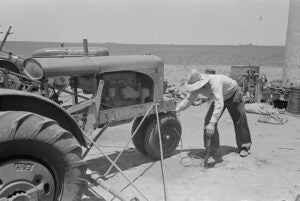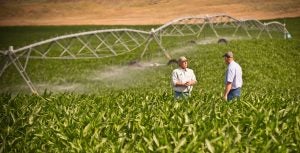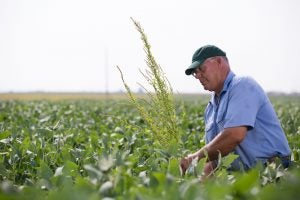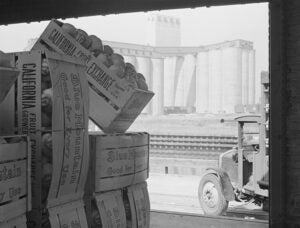Agricultural innovator and entrepreneur Robert Saik has a book out called, Food 5.0, which explores how farming has substantially changed over the past century, but also that the fundamental traditions are still there. These changes have done wonders for our ability to feed and clothe a growing population in efficient and dynamic ways, while also applying the stewardship that this industry demands.
Here are four examples of how some vital parts of farming have evolved over the last century:
1. Equipment
In the 1920s, most farmers were still using draft horses to plow and work the fields, however the rise of tractor use was beginning. By 1921 there were 186 different companies producing various types of tractors, which put nearly 200,000 of these machines into use on farms across the country.
These tractors were steam- and gasoline-powered, which made work easier and faster. Before tractors, it took 40 to 50 hours to produce 100 bushels of wheat on five acres, but by 1930, with the development and improvement of tractors it took only 15 to 20 hours!

The 1920’s-era tractors cost an average of $400, which is almost $7,000 in today’s dollars, still remotely cheaper than any tractor available on todays market. Equipment in the 2020’s often range from $10,000 to millions of dollars!
Equipment today is also heavily specialized for the production method it is used in. There is specific equipment for growing and harvesting wheat, corn, potatoes, tomatoes, and cherries — almost every single thing we eat has a piece of equipment that is used only in that production method.

In addition, there are significantly fewer companies today that produce the equipment used on farms. Today, there are barely a dozen major companies that produce farm equipment for the United States market, compared with the hundreds that were developing equipment in the 1920s.
2. Irrigation
Irrigation in the 1920s looked a lot different than in the 2020s. Wells were dug by hand, and windmills pumped water from the ground or body of water and to the land to water crops. Ditches were used to transport water across a field, and sometimes flood irrigation was used.

Today, farmers use center pivots to irrigate field crops, covering a large number of acres with just one pivot. Overhead and drip irrigation are also used in certain cropping situations, all of which utilize pumps that are gas- or electric-powered. We also have technology now that can control irrigation events from our phones or even automatically using soil moisture sensors!
3. Pest control
Pest control was an extremely laborious venture in the 1920s. There were minimal available chemicals that controlled weeds or insects, and they were expensive and not very effective.
During this time, it was still common to produce what your family needed and only a little extra to sell to market. Large commercial farms that specialized in one crop didn’t become more popular until the next decade or so. Therefore, infestations of insects and weeds weren’t as damaging to the overall cropping systems. However, if you did experience pressure from one of these pests, it was an all-hands-on-deck method to remove the pest by hand. Scouting was a vital part of managing any issues on your farm and this was done by walking through the fields constantly.

In the 2020s, we have a plethora of pest control methods including targeted synthetic chemicals, pest resistant crops, and mechanical/equipment use — not to mention a whole lot more knowledge than we did back then. Scouting is still an essential step to pest control these days, but it looks a little different. Now we can scout with drones and advanced imagery, trucks, utility vehicles, and in some cases we even scout by airplane or helicopter!
4. Selling and transporting products
In the 1920s there were no large production factories producing pre-packaged goods to sell. Farmers did most all of the work to market and sell their products. Most products were transported on steam-powered trains. These trains had to stop every 20 to 40 miles to fill their water tanks so they could power on to the next town.

Nowadays, many crops are still transported by train, however they are powered by fossil fuels now. Add in commercial shipping for imports and exports, semi-trucks, airplanes, and small delivery vehicles, now there are significantly more options to get farm goods to market and eventually the end consumer.
The day-by-day of farming may look a lot different than it did 100 years ago, but in the end it is still the same. Hard working people toil every day to produce safe, wholesome food for the country then and now.
Michelle Miller, the “Farm Babe,” is an internationally recognized keynote speaker, writer, and social media influencer and travels full time to advocate for agriculture. She comes from an Iowa-based row crop and livestock farming background and now resides on a timber farm in North Central Florida.



